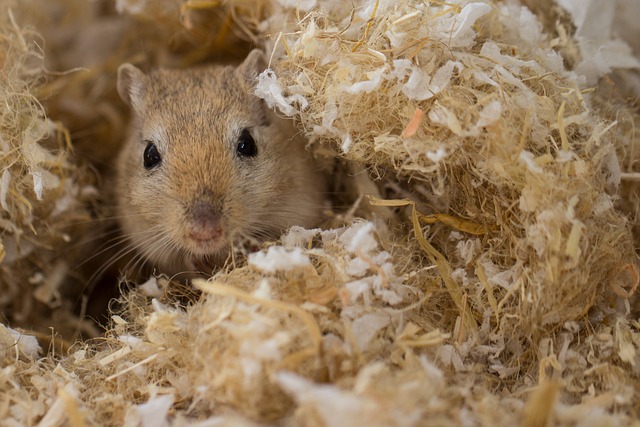No, it is not recommended to use beach sand for gerbils as it may contain harmful pathogens and parasites that can cause health problems for the gerbils.
Instead, it is recommended to use a specialized type of sand, such as chinchilla sand or dust, which is specifically designed for small animals like gerbils and is free of harmful substances.
This sand helps keep the gerbil’s fur clean and healthy by absorbing excess oils and moisture.
Key Takeaways
- Gerbils are desert animals that require a clean and healthy environment to thrive.
- Beach sand contains salt, minerals, and pathogens that can harm gerbils.
- Many alternative substrates are available that are safe for gerbils, including paper-based bedding and aspen shavings.
Beach Sand: Composition and Characteristics
Beach sand is a common substrate used for various pets, including gerbils. However, it is essential to understand the composition and characteristics of beach sand before using it as a bedding material for gerbils.
The composition of beach sand varies depending on the location and type of beach.
Generally, beach sand comprises minerals such as quartz, feldspar, and mica. It may also contain organic matter, shells, and other debris.
The texture of beach sand can range from fine to coarse, and it may be wet or dry, depending on the tide.
When using beach sand as a gerbil substrate, it is essential to consider the potential risks.
Beach sand may contain harmful bacteria, parasites, or other microorganisms that can cause health problems for gerbils.
Additionally, the texture of beach sand may be too abrasive for the gerbil’s delicate skin, causing irritation or injury.
Overall, while beach sand may seem like a convenient and natural option for gerbil bedding, it is essential to carefully consider its composition and potential risks before using it. It may be safer to opt for a commercially available gerbil bedding material specifically designed for their needs.
Impact of Beach Sand on Gerbils’ Health
Digestive System
When gerbils ingest sand, it can cause blockages in their digestive system. Beach sand may contain salt and other minerals harmful to gerbils’ digestive systems.
Ingesting sand can also cause dehydration, constipation, and other digestive issues.
Respiratory System
Beach sand can cause respiratory issues in gerbils. The fine particles of sand can be inhaled, irritating the respiratory system. This can lead to coughing, sneezing, and other respiratory problems.
Skin and Fur
Beach sand can also cause skin and fur problems in gerbils. The sand can get stuck in their fur, causing irritation and matting. This can lead to skin infections and other health issues.
To ensure the health and well-being of gerbils, it is best to avoid using beach sand as bedding. Instead, opt for safe and appropriate bedding materials designed for small animals.
Alternative Substrates for Gerbils
When choosing the right substrate for your gerbil’s cage, several options are available.
While beach sand may seem convenient, it is not recommended due to respiratory problems and ingestion risk. Here are some alternative substrates that are safer and more suitable for gerbils:
Paper-Based Bedding
Paper-based bedding is a popular option for gerbil owners. It is made from recycled paper and is highly absorbent, making it great for controlling odors and keeping the cage clean. Additionally, it is dust-free and safe for gerbils to burrow in.
Some popular brands of paper-based bedding include Carefresh and Kaytee Clean & Cozy.
Aspen Wood Shavings
Aspen wood shavings are another safe option for gerbils. They are soft and comfortable for gerbils to burrow in, and they are also absorbent and control odors well.
Unlike pine and cedar shavings, aspen shavings do not contain harmful oils or phenols that can cause respiratory problems. Some popular brands of aspen shavings include Kaytee Aspen Bedding and Living World Aspen Shavings.
Hay
Hay is a natural and safe substrate option for gerbils. It is soft and comfortable for gerbils to burrow in and provides them with a source of fiber for their diet.
Timothy hay is a popular choice for gerbil bedding, as it is low in calcium and high in fiber. However, it is essential to note that hay can be messy and may not control odors or other substrates.
When choosing a substrate for your gerbil’s cage, it is essential to prioritize safety and comfort. While beach sand may seem convenient, it is not worth the risk to your gerbil’s health.
Instead, consider using one of these alternative substrates to provide your gerbil with a safe and comfortable living environment.
Conclusion
In conclusion, while beach sand may seem like a cheap and convenient option for gerbil bedding, it is not recommended. The risks of using beach sand far outweigh any potential benefits.
Firstly, beach sand is not sterile and may contain harmful bacteria and parasites that can harm gerbils. Additionally, the high salt content of beach sand can cause dehydration and skin irritation in gerbils.
Furthermore, beach sand is not absorbent and does not control odor, leading to unpleasant smells and an unsanitary living environment for gerbils. It is also difficult to clean and may require frequent replacement.
It is best to use bedding specifically designed for small animals, such as paper-based or wood-based bedding. These options are safe, absorbent, and easy to clean, providing a comfortable and healthy environment for gerbils to thrive in.




